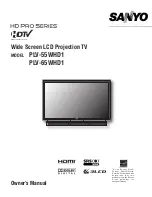
11
Terminals and Connectors
!1
R/C jACK
When using the wired remote control, connect the
wired remote control to this jack with a remote
control cable (not supplied).
q
USB CONNECTOR (Series B)
USB connector is used to service the projector.
u
S-VIDEO INPUT jACK
Connect the S-VIDEO output signal from video
equipment to this jack. (p.21)
i
SERIAL PORT IN TERMINAL
If you control the projector through RS-232C
from a computer, you must connect a cable (not
supplied) from your computer to this terminal.
o
SERIAL PORT OUT TERMINAL
This terminal outputs signal from SERIAL PORT
IN. More than two projectors can be controlled
through RS-232C from one computer by
connecting SERIAL PORT IN of another projector
to this terminal.
w
5 BNC INPUT jACKS
Connect the component or composite video
output signal from video equipment to VIDEO/Y,
Pb/Cb, and Pr/Cr jacks or connect the computer
output signal (5 BNC Type [Green, Blue, Red, Horiz.
Sync, and Vert. Sync.]) to G, B, R, H/V, and V jacks.
(pp.20–21)
q
w
r
t
y
i
t
DVI INPUT TERMINAL
Connect computer output (Digital/DVI-D type) to
this terminal. (p.20)
HDTV (HDCP Compatible) signal can be also
connected. (p.21)
e
D-sub 15-PIN INPUT TERMINAL
Connect computer output (Analog D-sub 15-pin
type) to this terminal. (pp.20-21)
Part Names and Functions
y
HDMI
Connect the HDMI output signal from video
equipment to this terminal. (p.21)
r
MONITOR OUT TERMINAL
This terminal can be used to output the incoming
analog RGB, component, or composite video
out signals from INPUT 1-2 terminal to the other
monitor. (pp.20-21)
e
o
u
!0
!0
LAN port
Connecting the Ethernet cable. See the owner's
manual of “Network Set-up and Operation” for
details.
!1












































